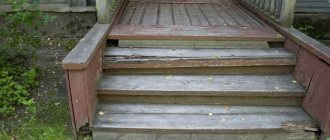About stairs
Website about stairs. We combine the experience of professionals and private craftsmen in one place
Popular
1 person discussing
Stainless steel staircase to the pool: characteristics, models, manufacturing instructions
4 people discussing
Staircases in Art Nouveau style: tips for creating a style
Wooden staircase on a slope - making your site comfortable and beautiful
How to assemble a wooden staircase - yourself and from ready-made elements
Finishing a monolithic staircase: considering possible options
Do-it-yourself staircase to the attic - installation of a stationary structure
Production of wooden stairs: ideas for small businesses and more
Iron staircase to the second floor - cold metal as an addition to home comfort
Do-it-yourself staircase in a wooden house - bringing beauty and comfort to the masses
Unusual and original stairs to a private house - choose your option
Porch after renovation
Everyone knows that nothing is eternal. Even when building to last, choosing the highest quality materials, over time there will be a need to restore the house, and the first thing that will be needed is repairing the porch.
It is this architectural structure of the building that bears the heaviest loads during operation, which leads to its deterioration. This article will tell you how to repair a wooden and concrete porch.
- Causes and Effects
- Foundation repair
- Repair of external parts of the porch
- Wooden porch repair
- Concrete porch repair
Causes and Effects
If the porch is constructed correctly, in compliance with construction technology, the structure should last 50 years or more without repair.
However, often the picture is different:
- The tree is rotting;
- Concrete – peeling off;
- Stone - destroyed;
- The tiles fall off;
- The structure tilted, its geometry changed;
- Cracks appeared;
- The porch began to recede from the house;
- Mold and mildew form at the joints. It is very difficult to remove them, and it is almost impossible to paint them over.
Why do such troubles happen? There is only one answer - the foundation was not executed correctly.
This may be related:
- With poor waterproofing;
- Lack of a good drainage system;
- Violation of SNiP standards when connecting the extension and the building.
Even if you carry out a major overhaul of the porch with your own hands every year, reinforcing the structure with metal corners, cementing the surfaces, they will crack. Heaving forces begin to act on pushing and compression; if the foundation is incorrect, the extension will warp, and subsequent deformations will occur.
And if the organization is poorly organized, or there is no waterproofing at all, during the rainy season or the presence of a high groundwater level, the materials will become saturated with moisture. At negative temperatures, water turns into ice, which simply tears the structure from the inside.
Concrete porch construction technology
The process itself is simple, but for convenience it is better to divide it into separate stages:
- planning;
- digging a foundation pit and pouring it;
- preparation for pouring the above-ground part - production of reinforcement frame, formwork;
- pouring the stairs;
- finishing, for example, special concrete tiles for the porch, guarantees excellent grip in winter.
Let's look at each stage in more detail.
Porch project
There are no special technical refinements in this design, so the main emphasis when drawing up the project is on the comfort of using the porch.
At the preparation stage, you need to take into account several features of the “ideal” structure:
- It is undesirable for the top step to be located almost flush against the door. In winter, this can make it difficult to open the door due to snow or ice that has accumulated overnight. A gap of 7-10 cm is considered optimal;
- a concrete porch must have an odd number of steps; it is believed that it is more convenient for a person to step on and leave the stairs with the same foot.
Note! It is easy to estimate the height of the step knowing the distance from the ground to the expected top of the porch. The golden mean is considered to be up to 5-7 steps.
- the width of the step should be such that even a person with large feet does not have a heel hanging down; 25-30 centimeters will be enough;
Approximate step dimensions
- As for the width, one meter will be enough so that 2 people do not push each other, but calmly separate on the steps.
When preparing, it would be useful to draw out the future porch on graph paper. Even in a well-thought-out design, unobvious shortcomings can appear.
Foundation
The instructions for performing the work require digging a pit below the freezing depth by about 10 cm. In practice, given that the adjacent room is most likely heated, it can be reduced by 30 percent (if the minimum temperature in the room is +10ᵒC).
Foundation diagram
Usually, no one works with a climate reference book when choosing the freezing depth for a region, but simply builds a pit approximately 45-60 cm deep.
The following must be taken into account:
- A gravel-sand cushion must be placed at the bottom of the pit. First, a layer of sand - 10-15 cm, on top of it - gravel or crushed stone 10-15 cm;
Note! Crushed stone can be completely replaced with broken bricks. This approach will partially solve the problem with construction waste, and when the porch is poured with concrete, there will be no difference.
Brick brick perfectly replaces crushed stone
- It is also necessary to install a knitted (or welded) reinforcement frame; class A-III reinforcement is used, diameter 12 cm. A mesh is laid out at the bottom of the pit in increments of 15-20 cm. The height increment is 15 cm.
Preparation for pouring the ground part
A rather important stage is the creation of formwork. It can be used either thick plywood or boards approximately 1.5-2.0 cm thick.
Note! It is better to additionally reinforce the plywood with strips in increments of 30-50 cm. They will act as stiffeners and will prevent the sheet from bending when pouring concrete.
As for how to concrete a porch, this issue should be addressed last.
First you need:
- manufacture and install a reinforcing cage (the spacing between the reinforcing bars is indicated above);
- prepare, assemble and install formwork. For greater strength, the transverse strips separating the individual steps can be fastened together. Only after the entire structure has been assembled can the concrete mixture be prepared and poured.
Everything is ready to pour concrete
Note! To ensure that the formwork can be easily removed after the concrete has hardened, it can be covered with a smooth cloth.
Pouring concrete and finishing the porch
We concrete the porch carefully, the mixture can be loaded in any available way, you just need to make sure that the crushed stone does not get stuck in the frame and that cavities do not form in the thickness of the porch.
If a manual concrete mixer is used, then the tray is simply directed into the porch and the mixture drains itself. If the concrete was prepared manually in a handy container, then it can be loaded with a simple shovel. The main thing is to periodically level the mixture and not dump it in a heap; the mixture is quite rigid, so it will not spread on its own.
The mixture must be distributed manually
When pouring, in order for the concrete stairs for the porch to be neat, each step is carefully smoothed, the transverse strips clearly delimit the individual steps and do not allow them to float. After this, all that remains is to cover the fresh concrete with a film so that it does not crack when drying.
Fresh concrete must be covered with film
As for finishing the porch, the only limit is the builder’s imagination. If the house is wooden, then the concrete can, for example, be covered with a block house. If the house is made of stone, then tiles that imitate natural material would be appropriate. It is recommended to lay horizontal surfaces with tiles that remain rough even in wet weather; all finishing work can also be done with your own hands.
The porch is ready for finishing
Foundation repair
If cracks appear on the surfaces of the structure or the porch is skewed, repairs should begin with the foundation.
For this:
- The foundation base is excavated along the perimeter of the porch to its entire depth;
- Cleared from the earth;
- The design is carefully examined for defects.
Advice: If the base is damaged, made with violations, or is missing, the errors should be corrected, otherwise repairing the porch in a private house will become a seasonal hobby for its owner.
- The extension is supported by barrels, jacks, and pillars.
When making a columnar base:
- Holes are dug in the corners of the structure;
- The bottom is leveled;
- Crushed stone and sand are poured, the thickness of each layer is 200 mm;
- Everything is carefully compacted;
- The pillow is covered with roofing felt, the joints of the material are overlapped 100 mm, and soldered with a burner;
- If a gap forms between the porch and the building, the structure must be fastened with metal corners and anchors during repairs, and an expansion joint must be left. It can then be decorated and painted.
Coupling the base of the house and the porch
The columnar foundation can be laid out of red backfill brick, you can use an iron pipe or a high-quality log. However, the strongest and most durable is a concrete column.
A little concrete is poured onto the previously prepared cushion, the reinforcement is installed strictly vertically, wrapped in two layers of roofing felt. The base is filled with concrete to the required height.
Installation of a columnar foundation
To install a strip foundation:
- A trench is dug around the perimeter;
- Formwork is installed;
- A reinforcing frame is installed;
- Parts of the foundation that are not interfered with by supports are poured;
- After a week, the supports are removed and the rest of the foundation is poured;
- After another 7 days, the formwork is removed;
- The side surfaces of the tape are carefully painted with bitumen mastic;
- Roofing felt is laid on top, which will protect the porch from moisture.
If, while digging up the foundation, it turns out that it exists and is laid according to all the rules, then the porch requires repair. This may occur due to the use of low-quality materials, or violation of the technological process of construction and finishing.
In this case it is necessary:
- Paint the sides of the foundation with bitumen, or cover with roofing felt;
- Spray a layer of polyurethane on top for insulation;
- Backfill the soil;
- The surface is thoroughly compacted.
Tip: When building a house and porch on different foundations, the pillars and tape should be tied to the foundation of the building with anchors, or with corners and dowel nails. For a small extension and high strength of the main foundation, holes are hollowed out in it until a reinforcing frame appears. Transverse reinforcement is produced from it to secure the base of the porch. But at the same time it is necessary not to harm the main foundation.
Repair of external parts of the porch
To repair the porch of a house, first of all, the material from which it is made is determined.
It can be:
- Tree;
- Metal;
- Stone;
- Brick;
- Concrete.
Therefore, repairs should be approached strictly individually.
Moreover, in any porch design there are:
- Ladder;
- Fencing;
- Vertical pillars;
- Area;
- Canopy.
The repair of the porch of a country house should begin with the repair and strengthening of the side elements, then the vertical supports and canopy, the last steps and fencing are repaired.
Painting porches
Both wooden and unlined concrete porches at the dacha need to be painted periodically.
Do-it-yourself painting of a wooden staircase
First, let's figure out how to properly paint a wooden staircase. First of all, of course, you need to choose a dye. What is the best way to paint a wooden porch? Since the street march is affected by various kinds of unfavorable environmental factors, acrylic paint or oil paint intended for outdoor use is most often used to paint it.
How to paint an outdoor porch. Acrylic enamel is one of the possible options
Tip: If you want to keep the natural texture of the wood of the porch of a country house visible, paint it with a special oil.
Painting a wooden porch is carried out in several stages:
- In the event that the boards of the steps were once fixed to nails and the heads of some of them came out, they need to be sunk into the wood with a hammer before painting.
- It is also recommended to prime the porch before painting.
- Next, the surfaces are primed. The porch can simply be painted with the same paint, only diluted thinner.
- After a few days you can start actually painting. The dye is applied to the steps, the floor of the upper platform and the railings in two to three layers.
When painting street stairs, use a brush or roller
Wooden porch repair
Repairing a wooden porch
To repair a wooden porch with your own hands, you need to:
- Clean the extension from the swollen old coating;
- All wooden parts should be carefully examined for the presence of black fungal spots;
- If affected areas are found, they can be cleaned, followed by treatment with a solution of copper sulfate, or better yet, replaced;
- Stringers are being repaired. In this case, you can make a part in the shape of a stringer, or take two bars or a board and screw them onto the inside of the element;
- Thoroughly clean all cracks, remove small rotten and rotten areas;
- To repair parts, a mixture is prepared consisting of epoxy resin with sawdust;
- With this composition, all defects are carefully repaired with a spatula.
- After the solution has dried, uneven areas are removed with sandpaper.
- The posts and fencing are reinforced with metal corners and self-tapping screws, and broken balusters are replaced.
Fungus on the tree
Rotten and rotten areas of the porch
Particular attention should be paid to repairing areas where the porch adjoins the house, where there should be no cracks. When the canopy moves away from the wall, it must be tightened with corners, and the joint must be sealed with reinforcing mesh using epoxy resin.
Repair of porch steps is necessary when they sag or when transverse cracks appear on the surfaces. To repair elements, a wooden panel made of hardwood, 40 - 50 mm thick, is suitable.
Laying new steps
After replacing all worn parts and repairing defects, you must:
- Sand the entire porch well;
- Impregnate with fire-retardant compound;
- Paint with antiseptic;
- All surfaces, especially the ends, are primed with two layers;
- To apply varnish, the wooden porch is painted with a transparent primer; before painting, the primer should be a neutral or light gray color;
- Smooth surfaces can be painted with a roller, and corners with a brush;
- If there are smudges and irregularities, they are cleaned with fine sandpaper;
- Dust is thoroughly blown away;
- Any enamel for external surfaces is applied on top, or painted with tinted wax or oil;
- To paint steps, you can use nonsleeve oil, which has a special additive with an anti-slip effect.
In addition to boards, decking can be used to repair the porch, which exactly imitates natural wood.
Decking
Its advantages: does not rot, does not support the appearance and development of fungus. Deck boards are most often already painted in production; they do not require finishing during repairs.
Tip: To make a wooden porch look elegant after repair, the structure should be decorated with ready-made carved elements. The price of a beautiful pattern on the canopy and figured balusters is not too high, but the porch will gain expressiveness and individuality, as in the photo. Such parts can be painted with any paints for exterior use.
Repair of porch steps
Porch decoration
Restoration of a wooden porch
Repair of wooden porches is most often aimed at eliminating the following problems: cracks in the flooring, rot damage to steps, balusters and fence supports. And almost every repair of a wooden porch is accompanied by fresh painting.
Restoration of balusters, supports and flooring
First of all, it is necessary to remove rotten areas of wood. And if the resulting loss of material is small, then the repair will only consist of applying several layers of putty. We dry each layer well and sand it, then apply the next one. Then you can start painting.
Repairing minor damage
Damage that is large in area but does not affect the load-bearing capacity can be repaired in the following way:
- Clean the surface.
- Apply a small amount of polyurethane foam.
- We cut the frozen foam to the shape of the part.
- We putty, prime and paint.
Photo of the reconstruction of the base of the support
If, after cleaning the wood from rot, it becomes clear that the bearing capacity of the support has decreased, then the repair will be as follows:
- Cut out four wooden rectangles.
- We cut the edges of each inward, at an angle of 45 degrees.
- We “encircle” the weakened area of the support with prepared rectangles.
For repairs, you can use nails or screws, depending on the size of the support. Before painting, be sure to fill the nail holes.
Strengthening the destroyed foundation
To repair a crack in the flooring, we will need a narrow wedge stick, a mallet, a plane and wood glue. Use a knife to adjust the wedge to the size of the gap and coat its sides with glue. Next, we put the workpiece into the opening, and then hammer it in with a mallet. Use a plane to plan the wedge flush with the floor boards. Now you can putty and paint the floor.
Porch floor: sealing gaps between boards
How and what is the best way to paint a wooden porch
Painting a wooden porch can be complete or partial. Before proceeding with the restoration, it is necessary to remove all the paint that has begun to “come off” from the boards. This is done using a belt, vibrating or eccentric sander. Then we repair all the cracks, covering the small ones with wood putty.
Repair of a wooden porch of a country house
Now you need to prime the tree. Drying oil is suitable as a primer for oil paints; for alkyd enamels and acrylic paints, you need to use alkyd and acrylic primers, respectively. You can read the number of layers and drying time in the instructions for the coating.











